Mystery Foto #6 Solved: The Jericho Turn in Jericho on a Vanderbilt Cup Race Course
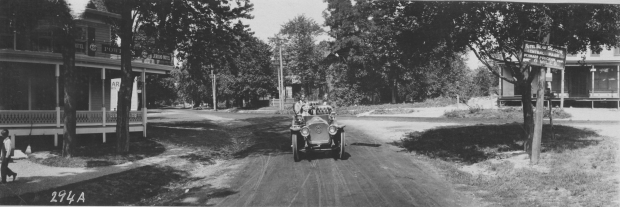
The Garden City Archives challenged you to identify another never-before-published Mystery Foto.
Mystery Foto questions:
- Identify the road and location of the Mystery Foto. What was the orientation of the photographer?
The Mystery Foto was taken on Jericho Turnpike in the hamlet of Jericho where it met with Oyster Bay Road (now Route 106). The photographer was facing east and slightly north.
- Identify the building on the left and the automobile.
The building was William Powell's Jericho Hotel, a popular hotel for the Vanderbilt Cup Race crowd. The automobile is described in the Garden City Archives construction book as a Garford distributed jointly by the Garford Company of Elyria, Ohio and the Studebaker Corporation of Sound Bend, Indiana.
- For which Vanderbilt Cup Race(s) was this section part of the course?
This section of the courses was used for the 1904, 1905, 1906 and 1908 Vanderbilt Cup Races.
- Where was the Hotel Beau Sejour located? Link this hotel to the Long Island Motor Parkway.
The hotel was located on the northwest corner of Central Avenue and Stewart Avenue in Central Park (now Bethpage). It was a popular location for Motor Parkway motorists which they promoted on their advertising. See the below excellent Comments.
Comments (13)
Congrats to Paul Parisi, Ron Ridolph, Greg O, Al Prete, Steve Lucas, Joseph Oesterle, Art Kleiner and Tim Ivers for identifying the location of the Mystery Foto.
Kudos to Art Kleiner for identifying this location for four Vanderbilt Cup Races.
Special shout-outs to Gary Hammond and Art Kleiner for their great research on the Hotel Beau Sejour.
Enjoy,
Howard Kroplick
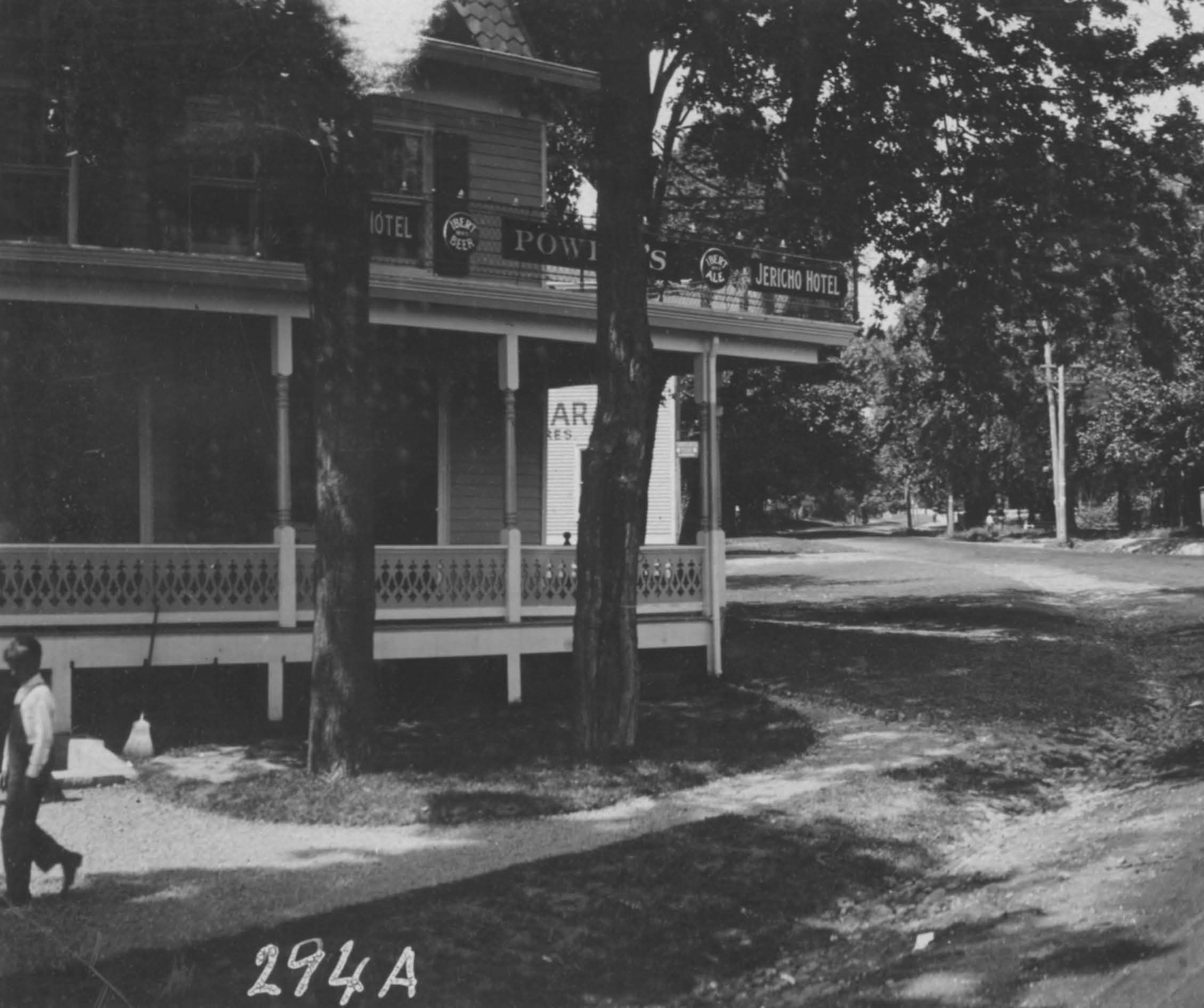
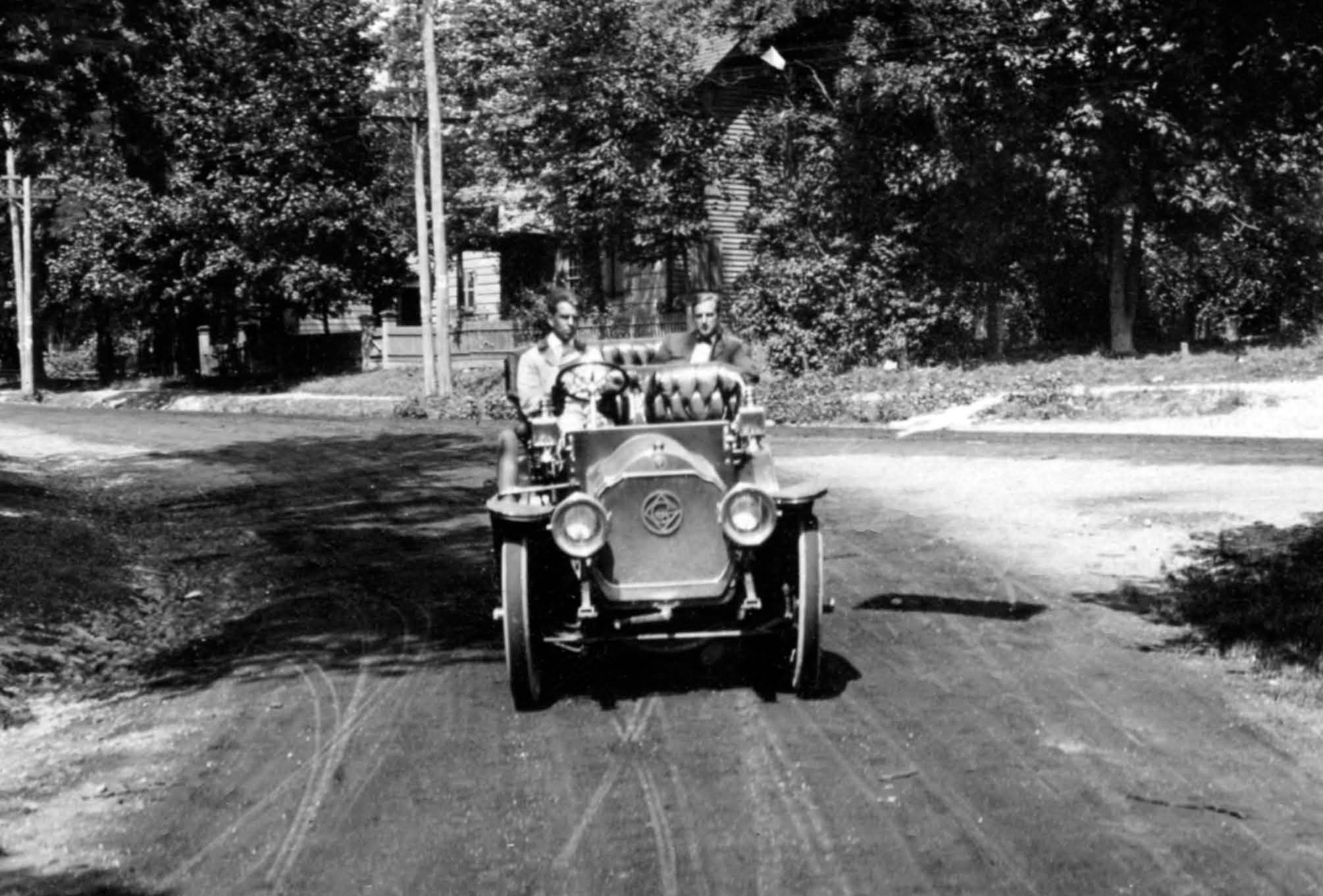
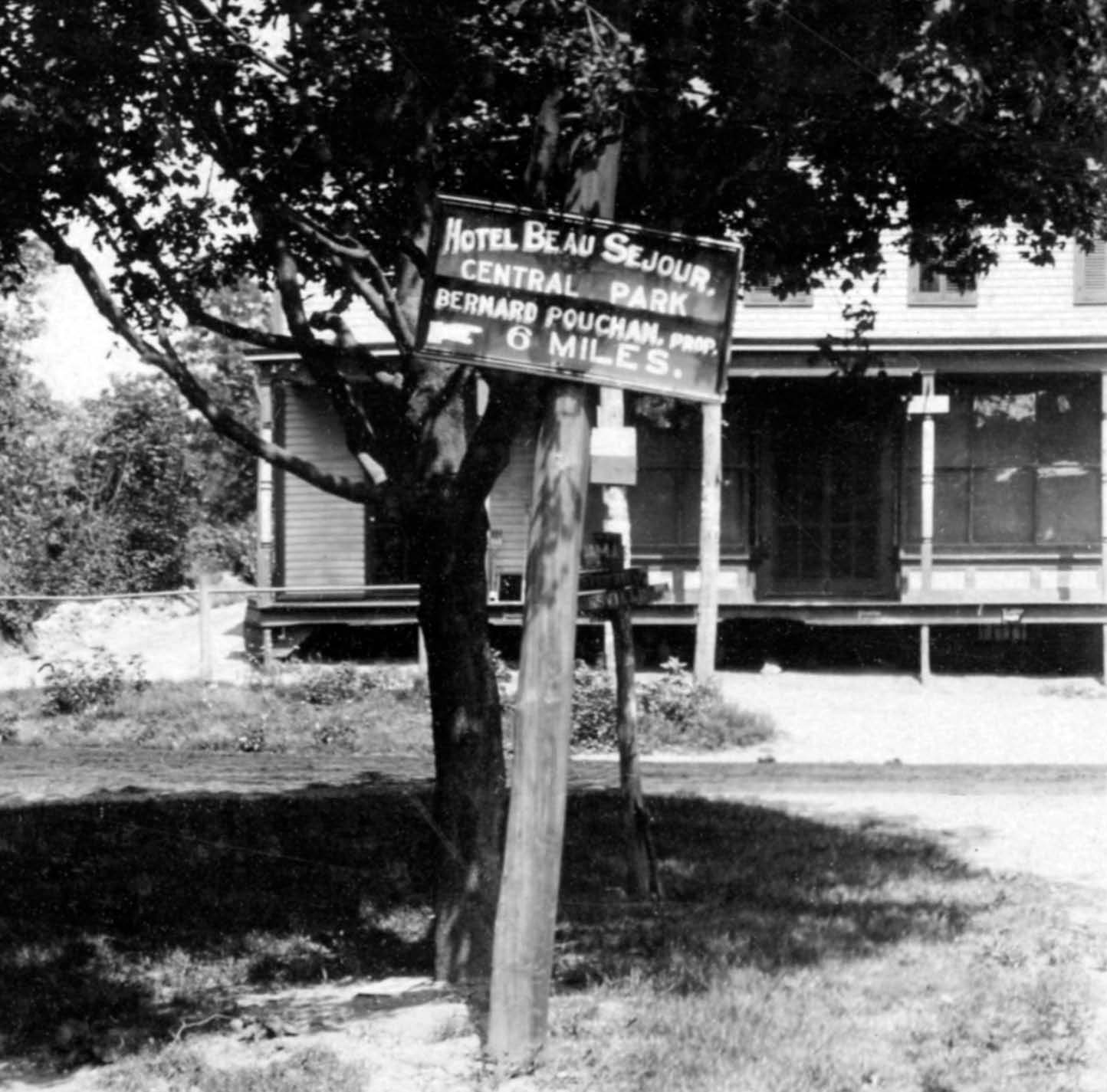
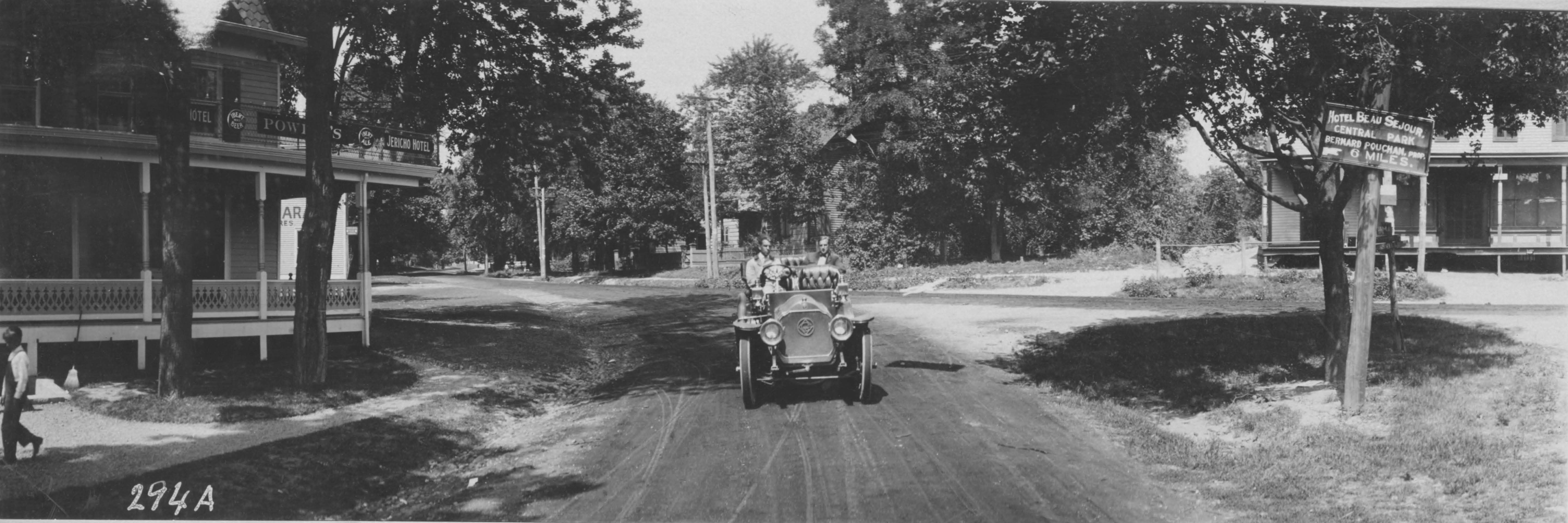

Comments
Labeled the ‘curve of death’ by newspaper writers it was at Jericho turnpike and what we know it today as route 106-107 in Jericho.
I believe the photographer was facing north.
Building on left is the W.B. Powell’s Jericho Hotel.
First turn of the 1904 cup.
Hotel Beau Sejour was on the northwest corner of Central ave and Stewart ave in Bethpage (Central Park) and was a popular stop for motorists for close proximity to the LIMP.
*Photo left of Automobile is Powell’s Hotel, Jericho, NY
* Other photo is Beau Sejour Hotel on Central Avenue, Bethpage, NY.
Identify the road and location of the Mystery Foto. What was the orientation of the photographer?
-Jericho Tpke, Jericho looking Northward.
Identify the building on the left and the automobile.
-Jericho Hotel. But more importantly, just beyond the hotel, you can see a sliver of the D.F. Maltby Automobile Garage. The garage was the Locomobile headquarters for the 1908 Vanderbilt Cup Race. Unsure about the auto and no time for research.
For which Vanderbilt Cup Race(s) was this section part of the course?
-1908
Where was the Hotel Beau Sejour located? Link this hotel to the Long Island Motor Parkway.
-The Hotel Beau Sejour was located in Central Park (today’s Bethpage) until its closing in 1974.
The road is Jericho Turnpike, just west of Woodbury Road. The photographer is looking east (rationale: the sign pointing to the right). The building is W. B. Powell’s Jericho Hotel. This was part of the VCR course in 1908.
The sign says “Central Park” which was the old name for Bethpage, so Bethpage is where the Beau Sejour Hotel was. I found that it was at the NW corner of Central Avenue and Stewart Avenue. Built in 1847, torn down in 1973. (Google Maps calculates 6.6 miles via one route, not too far off from the sign in the Foto.) The connection to the LIMP is it hosted the carriage trade that utilized the parkway. It was known for its fine dining.
Cars of that era all look like carriages with a motor where the horse used to be. I have no clue about the car. The logo on the radiator might be a clue for someone.
Hicksville? For the Beau Sejour location, see my LIMP Maps page 1 <http://sbiii.com/limpmap1.html#BethCent>, “(formerly) at the NW corner of Stewart and Central Avenues, long reputed to be, or contain part of, a LIMP Toll Lodge [highly unlikely - the Beau Sejour mansion was built in 1847 and sold to Harry G. Wilson in 1918 when it became a restaurant hosting the carriage trade from the LIMP - it was sold and demolished in 1973 - per Central Park Historical Society].” Sam, III
I think we’re looking east on Jericho Turnpike at the intersection with the road to Oyster Bay (today’s route 106). Powell’s Jericho Hotel is on the left. Behind the hotel appears to be D. F. Maltby’s Automobile Garage, headquarters for the Locomobile during the Vanderbilt Cup Races. The 1905, 1906, and 1908 races used this section as part of the course. As the sign indicates, the Hotel Beau Sejour was located 6 miles south in Central Park (Bethpage) on the N/W corner of Central Avenue and Stewart Avenue. Since it was one of the better hotels around and quite close to the LIMP, it was a popular gathering spot before and after the races. As for the vintage automobile, I’ll leave that for the “Brass Era” experts.
Jericho Tpke and Route 106. The car is heading west. Past the Jericho hotel. Behind it the roads used to combine for about 300 yards, before 106 headed north and Jericho Tpke continued east. This is the best photo I think i have ever seen of this intersection. Of course, today, you would never believe it is the same place.
Identify the road and location of the Mystery Foto. What was the orientation of the photographer? Jericho Turnpike (Jericho) intersecting Rte. 106 (Oyster Bay Road) - “The Curve of Death”. Looking Northeast?
Identify the building on the left and the automobile. Powell’s Hotel. Will leave the auto to the experts.
For which Vanderbilt Cup Race(s) was this section part of the course? 1904, 1905, 1906, 1908.
Where was the Hotel Beau Sejour located? Link this hotel to the Long Island Motor Parkway. Central Park (Stewart Ave. and Central Ave.) Close to the Motor Parkway so travelers often stopped at the Hotel to eat and a rest.
Forgot to add my bonus Mystery Question: who is the person in the lower left hand corner of the photo? Some more pics of the Beau Sejour.
Looking northeast at South Oyster Bay Road and Jericho Turnpike about 1908.
On the left is Powell’s Jericho Hotel.
The 1908 race used this route.
The Beau Sejour, a landmark restaurant, was on Central Avenue, Bethpage, just a stone’s throw from
the Massapequa toll lodge on Rte 107 (Hicksville Road). Many patrons of the LIMP dined there..
Howard this is “A Brief History of the Beau Sejour” that I wrote for my history of Central Park / Bethpage that unfortunately was never published.
One of the most famous landmarks in Bethpage was the Beau Sejour. It was located on a plot of land occupying the northwest corner of Central Avenue and Stewart Avenue, and bounded on the west by Pershing Avenue and on the north by Kearney Ave. What is known about the Beau comes primarily from two sources: in April 1970 the Thomas Powell Yorkers of Bethpage High School published “An Architectural Survey of Bethpage, L.I., and Environs” which provided documentary evidence of the physical description of the site along with land ownership; in addition, the Wilson Family, who owned the Beau for most of the 20th century, have provided a tradition of family history documenting their ownership.
The Beau Sejour was built on land bought by William C. Hauxhurst in 1847. Sometime between 1847 and 1853, when Hauxhurst sold it, along with 31 acres located between Central Ave. and the railroad tracks to John S. Walters, the house was built. Tradition has it that a team of horses were driven around in a circle on the grounds in order to mix the mortar needed for construction when being built. What is definitely known is that the bricks for its manufacture came locally from Ephraim Smith’s brickyard in Bethpage. As Smith had purchased his property in 1849, it appears that probably the Beau was built about 1850.
The original building was a large, box-like brick structure, with its kitchen being located in the basement. The original fireplace and oven was approximately eight to ten feet across, and three feet deep. The original framing members of unshaved beams were exposed down there. The first floor level had walls measuring 23 inches thick. The wood sash windows were four over four glass panes measuring 38” wide by 88” high. These windows had replaced the original six over six windows evident in early postcards. Located here in 1970 was the kitchen, bar and three dining rooms. The second floor served as an art gallery, once again with wood sash windows measuring 38” by 88”, composed of six over six glass panes. Obviously, both of these floors were remodeled when the building was converted into a restaurant in 1908. The third floor retained its original appearance. The floorboards were 12” wide, the doors 7½ high, with plaster walls throughout the roughly fifteen rooms on that floor. The windows were horizontal, made of three panes, measuring 17½”high by 40½” wide.
Completing the top of the building was an octagonal belvedere on the center of the roof. Its walls measured 55½” per side, and it was 12 feet 4” across. The six by six wood sash windows once again measured 38” by 88”. A wood flagpole, which prominently showed up in old postcards and photographs, ran through the center of the belvedere and up through its roof. From here one could easily spot the four corner chimneys. Additionally, around the flat roof hung wide eaves with decorative brackets.
In its original form both the front (east) and rear (west) sides of the building had 5 window openings across all 3 floors, while the sides (north & south) had only 3 openings at all 3 levels. The first floor, front side had a center door instead of a window opening. At the turn of the 20th century this door sported a small railed porch, which later would be expanded to a full width screened porch, and still later a closed-in windowed porch.
After the turn of the 20th century, when the building became a restaurant, two wood additions were made to the original building. One, located on the west side contained the kitchen, with the other, a dining room, was on the north side and extended around the east and south sides.
Prior to the first week of February 1970, the original barn stood near the southwest corner of the property. This building was demolished at that time due to the widening of Central Avenue. At the same time, a tree dating from the time the Beau was built (ascertained by tree ring counting) was also taken down. This tree was located on the southeast corner of the property at Central and Stewart Avenues.
An extensive list of property owners followed John S. Walters’s sale of it, along with property on the opposite side of Central Avenue to Alexander McConochie in 1856. In 1859, Jeremiah T. Weaver (1818-1890), the son-in-law of Alexander McConochie, was living in the Beau, even though it was then owned by Truman Richards. Weaver was a prominent resident of Central Park, who had previously been the Postmaster in Jerusalem Station (appointed January 29, 1857). He would become the first Postmaster of the newly created Central Park P.O. on March 1, 1867.
It seems that every couple of years the property changed hands until the turn of the 20th century. In 1897 the Beau was purchased by James J. Powers, and run as a hotel by his family. In 1908 Bernard Pouchan purchased the building and opened it as a restaurant. It is assumed that it was at this time that it was named the “Beau Sejour”, which means “beautiful stay”. Bernard Pouchan was born in France in 1860, having immigrated to the U.S. in 1891. He was described as being 5½ feet tall, with gray eyes and hair and sporting a mustache. The building of the L.I. Motor Parkway, along with the annual Vanderbilt Cup Race brought business to Central Park, including the Beau Sejour.
On April 11, 1909, The Brooklyn Daily Eagle ran a full page article entitled “A Day With Monsieur Le Cordon Bleu at the Hotel Beau Sejour”, complete with several pen and ink sketches of Bernard Pouchan in his chef’s outfit.
One postcard boasts “Hotel Beau Séjour, Central Park, L.I., 30 miles from New York City, HUMBERT, late of Café Martin, Proprietor, Tel. 91 Hicksville – The Leading French Hotel on Long Island”, the map on the back of the card shows the L.I. Motor Parkway as the route to take. Humbert Possenti (his real first name was Umberto) was listed in the 1915 N.Y.S. Census as a 37 year old Hotel Keeper, having been born in Italy, and coming to the U. S. in 1901. He was living with his French born wife, Isabelle, and his two children. As Pouchan was in Germany in 1914-15, obviously Possenti was running the Beau at this time.
Another postcard, evidently from the 1940’s, states “Country Dining Par Excellence… [Open] 12 Noon to 9 P.M….Closed Tuesdays”. Still later, from the 1950’s, it states “the Right Road to Gracious Dining…Let a superb meal at Beau Sejour climax your pleasant drive through lovely Long Island”. A multi-fold card, it includes a listing of the “Specialties of the House” on the menu.
In 1918, Bernard Pouchan sold the Beau Sejour to his sister-in-law and her husband, Elizabeth and Harry Wilson. Among the famous guests of the Beau were Roald Amundsen (the famous Norwegian Polar explorer), Enrico Caruso, General George C. Marshall, and President Harry S. Truman. The Wilson family would continue to own the Beau Sejour Restaurant until its demise in 1974. In December of 1974, the venerable Beau Sejour Restaurant was torn down. In its place would eventually be built a Pizza Hut and an Arthur Treacher’s restaurant.
Having been a large part of the community for nearly 125 years, the Beau Sejour was sadly missed then, and is still missed today, having played a vital role in the development of Bethpage.
I have attached some images, plus 2 of the Jericho Hotel.
Gary
Additional photos
Article about Bernard Pouchan of the Beau Sejour
As long as we’re at today’s 106 and Jericho Pike, the common area just north of the Pike, where 106 and 107 are coincident, hosted the Maine Maid Inn (now reborn as Scotto’s One North, 4 Old Jericho Tpke.), Valentine Hicks’ 1789 home, famed as a stop on the Underground Railroad. When the roads were widened ca. 1980{?}, the area was totally chaotic and the Inn was all-but -inaccessible so they put up a hand-painted wooden sign in the form of an arrow pointing to the east along Old Cedar Swamp Road, mis-labled “TOMAINE MAID”. This was before cell phone cameras and how I wish I’d remembered to go back with a film camera (or to have “acquired” the sign when the roads were finished)! Sam, III
My Father loved the Beau Sejour restaurant; he had his law office in Bethpage—and this restaurant was a beloved landmark. I remember it as a small child. Yes, this establishment is sorely missed. Everything possible should have been done to preserve it. That it was not saved is a true tragedy. I am heartbroken over its loss.
I want to thank the earlier posters for providing such wonderful photos and information. Much appreciated.